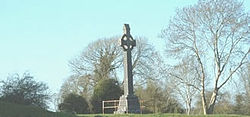Aughrim, County Galway
| Aughrim Irish: Eachroim | |
| County Galway | |
|---|---|
 The Aughrim Cross | |
| Location | |
| Grid reference: | M785281 |
| Location: | 53°18’15"N, 8°19’0"W |
| Data | |
| Population: | 595 (2011) |
| Local Government | |
| Website: | Loughrea.ie |
Aughrim is a small village in County Galway, located between the towns of Loughrea and Ballinasloe, along what was the main road between Galway and Dublin (now bypassed and listed as R446 regional road). This is a quiet place, apart from the M6 motorway roaring past, but is famed for a moment in history when a bloody battle was fought here in 1691.
The name of the village is from the Irish Eachroim, meaning 'Horse ridge'. It is a name found in a number of villages and townlands across Ireland.
The Irish census of 2011 recorded Aughrim with a population of 595.
Contents
History and archaeology
Two ringforts or raths, known as the Aughrim Ringforts are located to the south (in Attidermot townland). They have been declared a National Monument.
On 12 July 1691, during the Williamite War in Ireland, the two armies met at Aughrim. The Marquis de St Ruth prepared the Jacobite Irish troops at Aughrim, before marching out to battle. The Battle of Aughrim which followed was one of the most bloody battles ever fought on Irish soil – perhaps 7,000 men fell on both sides. Cavalry, infantry and artillery on each side engaged across the field and the river causeway; the struggle was in the balance until the Marquis of St Ruth was decapitated by a cannonball and the Jacobite position collapsed. King William's men prevailed. Galway surrendered and with it the last effective Jacobite position in Ireland. The place became known as Eachdhroim an áir, meaning 'Aughrim of the slaughter'.
Today Protestant communities across Northern Ireland celebrate 12 July each year, though the celebration is attributed to the Battle of the Boyne, which was actually fought eleven days earlier, with the excuse of a change in the calendar. It is mentioned too in the chorus of the Orangemen's song The Sash:
'It is old but it is beautiful
And the colours they are fine
It was worn at Derry, Aughrim
Enniskillen and the Boyne
My father wore it as a youth in bygone days of yore,
And on the Twelfth I love to wear the sash my father wore.'
A cross stands on the battlefield by Aughrim as a commemoration.
In 2009, the M6 motorway driven across the battlefield, despite protests by historians, environmentalists and the Orange Order.
Holy Trinity Church
Holy Trinity Church is the Church of Ireland parish church for Aughrim. It was built in 1819 and consecrated on Trinity Sunday 1819 and it was therefore called Holy Trinity. It is cruciform in shape and is still in use as a parish church [1]
Aughrim Interpretative Centre
The Battle of Aughrim Interpretative Centre,[2] in Aughrim Village was opened in 1991. It is a collaboration between Aughrim Heritage Committee, Ireland West Tourism, and Galway County Council.
The centre houses artefacts gathered up from the battlefield site as well as three-dimensional displays. There is also a documentary film that explains the course of the battle and its significance in the wider context of the history of Ireland [3]
Outside links
| ("Wikimedia Commons" has material about Aughrim, County Galway) |
References
- ↑ Aughrim Union of Parishes
- ↑ "Battle of Aughrim Centre". http://www.galway.ie/en/services/leisure/battleofaughrimcentre/. Retrieved 24 April 2016.
- ↑ "Remembering Aughrim, July 21, 1691". Galway Advertiser, July 24th, 1997. http://places.galwaylibrary.ie/history/chapter283.html. Retrieved 24 April 2016.
- 'Illustrated road book of Ireland, Second Edition', Automobile Association, London (1970)